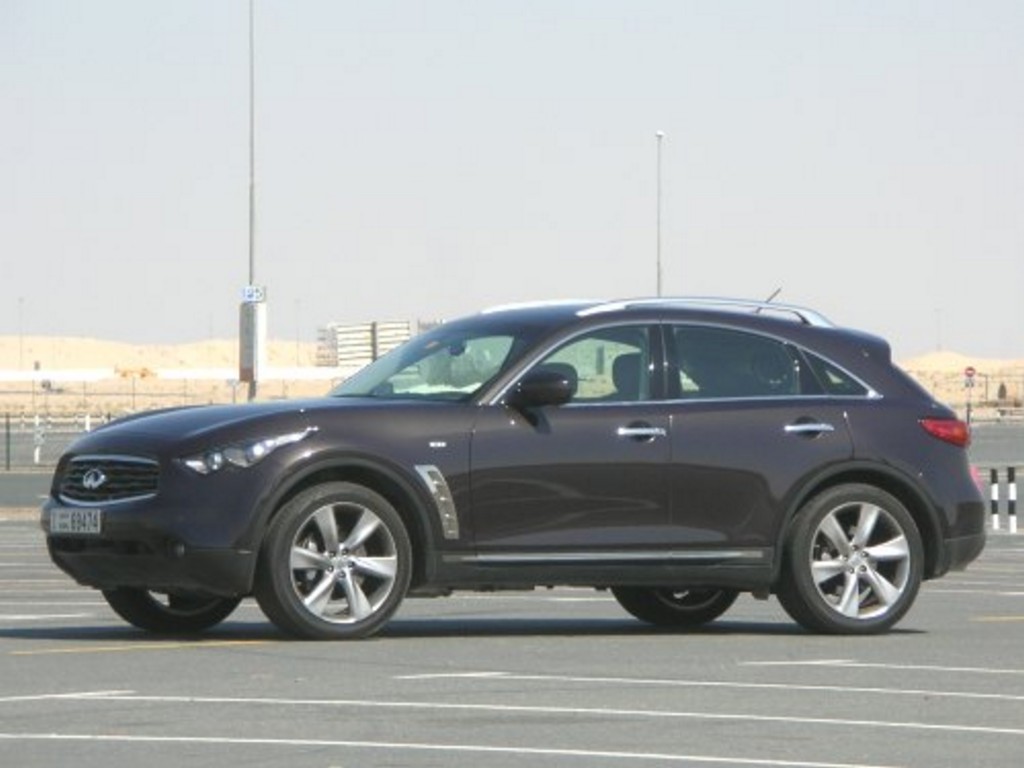2009 Infiniti FX50

| The Good: – Aggressive styling – Excellent cabin materials – Decent ride-handling balance |
The Bad: – Limited rear legroom – Limited cargo volume – Limited off-road ability |
The original Infiniti FX was stunning as a styling job. While we’ve never had an inkling for crossovers, it was one softroader that would get a free pass from us. We actually wondered how impossible it was better that clean design, and we think Infiniti had the same idea. Because they went with idea of keeping it largely similar, and yet completely changing its face from mild to wild.
The aggressive new front end is easily the most noticeable aspect of the FX now, with bulging pointy headlights, muscular bonnet and a watery-wave grille. Love it or hate it, the new look is as original as it gets. However, the rest of the midsized 4×4 looks no different from the previous version, except for new 21-inch wheels, tail lights and fender vents. While still highly attractive, not many will be able to tell the difference between a new model and the old one, if seen from any angle other than head-on.
The interior is a definite improvement over the previous version, with curvy shapes and multicoloured materials, integrating trademark Infiniti touches such as an analogue clock and that crowded central computer. The extensive use of soft-touch materials, even on below-the-belt cabin panels, brings the Infiniti up to German luxury standards. There are no signs of cost-cutting at all, except for a panel of blank buttons below the steering wheel which are reserved for optional electronic features, even in our top-of-the-line FX50 S model.
The seats and door panels in our tester were in an unattractive brown colour, although others may like it. The powered front seats were highly adjustable, well-bolstered, came with an extending thigh support and were even ventilated with fans. Unfortunately the rear passengers don’t fare as well, with compact-class rear legroom. Overall headroom isn’t abundant, but still enough for most people. The cargo volume remains below average, thanks to the short rear and sloping tailgate, but there are a few storage cubbies and enough cup-holders spread about.
There is no shortage of technology to play with in the FX, but they complicated to dig through. Having driven various other Infiniti models before, we should be used to the touchscreen interface, but we are not. We hear there are navigation, Bluetooth and 360-degree camera systems buried somewhere within the buttons. At least the CD stereo was strong, and the a/c was stronger. The great digital climate control had additional vents but no separate controls for rear passengers. Other features include HID headlights, cruise control, parking sensors, keyless start, rear-seat DVD screen, sunroof and multiple front-side airbags.
The mechanical specs certainly look good on paper. The 5.0-litre V8 is capable of 390 hp at 6500 rpm and 500 Nm at a high 4400 rpm which, according to independent tests, is enough to power the 2080 kg crossover from zero to 100 kph in well under 6 seconds. But of course, being the last people in the GCC to review an FX, we got a heavily-used tester with 10,000 km on the clock, which is about the only reason we can think of for our own test numbers. We managed a dismal 0-100 kph time of 6.9 seconds, with an awful fuel consumption figure of 22.1 litres per 100 km. Indeed, after our first drag run, a yellow warning light came on in the gauge cluster, but it disappeared after we restarted the car. All this is really odd, because our FX50 certainly felt strong and ran well throughout our February test.
The suspension did not falter, as the all-wheel-drive FX50 handled corners like a car. Our tester came equipped with the adjustable air suspension option, with ‘Auto’ and ‘Sport’ settings. While it was hard to discern any difference between the two settings, the FX did handle noticeably flatter than the smaller EX35, making it feel more confident around sharp turns. However, weight comes into play rather early, and understeer sets in with a loud squeal as the front tyres go wide in high-speed when hustling through tight bends. On that front, the Germans still own the game.
The ride is firm, but still comfortable enough, maybe more so than that of a BMW X5. This in itself is notable, because with low-profile 265/45 tyres on huge 21-inch alloys, we would’ve expected a harsher ride. There is a distinct lack of wind noise at highway speeds, but road noise from the wide tyres is a bit noticeable. The steering and the brakes are on par with the competition, delivering precision while lacking enough feedback. And parking is easy enough with the rear camera, even if visibility is close to nil out back.
The FX50 straddles the line between sports-car and SUV, but it does neither to perfection. The paddle-shifted 7-speed automatic is a smooth unit on its own, but the paddle responses are a bit delayed, making them annoying in spirited driving. And there is no point talking about its off-road capabilities. Ignoring the fact that there is no low-range gearing, there isn’t even enough ground clearance for anything more than a day at a flattened beach.
What the FX has is character. It is the only selling point for this road-going 4×4. The straight-line performance is a supposed bonus too, although we witnessed none of that in our test. However, it remains quick enough, both on the highway and around corners, seats four adults and a midget, carries a few shopping-mall bags and has enough style to stand out among the idolised Europeans. That, for some people, is all they need from a car.












There are no comments. Be the first!